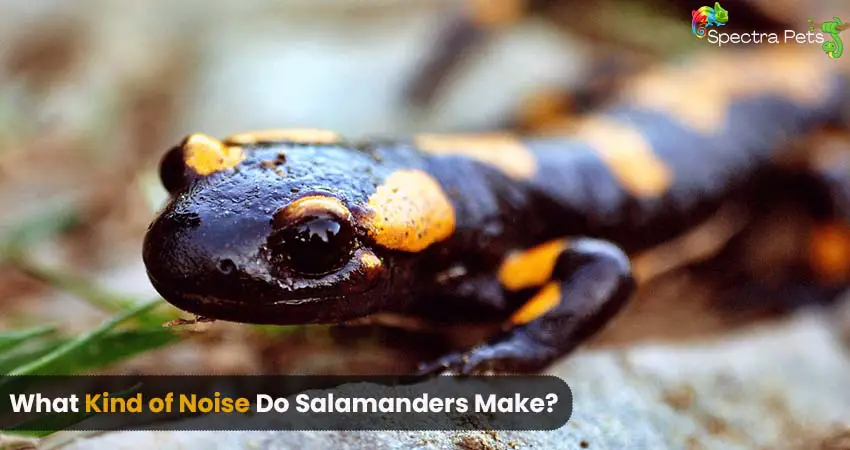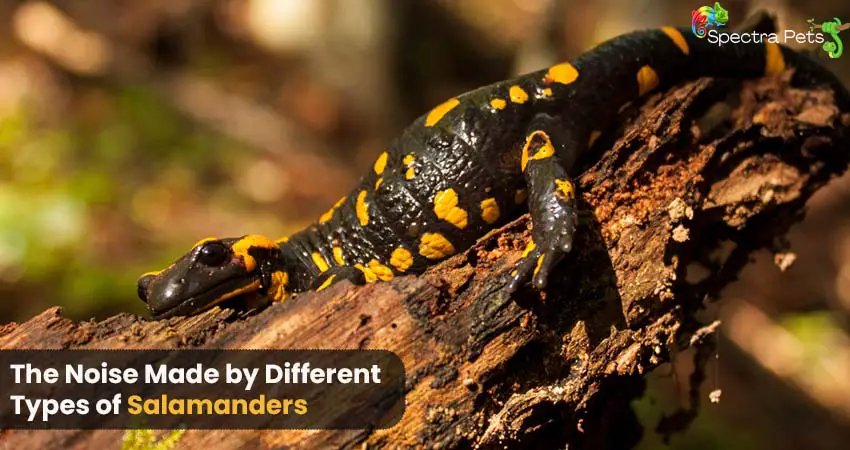A pet owner who is invested in this hobby would love to learn everything about their pets. It doesn’t just end with their behavior or food preferences, rather boils down to the minute details, the type of noise they make for example.
Now, it’s easy if it’s a cat or a dog, even a frog! Because we’re used to it. But creatures like the salamanders are hard to figure out. And if you’re a first timer, I’m sure you’re totally fired up to learn how they sound.
I have it fully prepared for you. All you need to do is scroll…
What kind of noise do salamanders make?
Most salamanders are generally quiet animals and do not make any noticeable noise. Some species of salamanders may produce faint, high-pitched calls or chirps, but these sounds are not typically audible to the human ear.
Unlike birds, mammals, and reptiles, salamanders do not usually have vocalizations. Instead, they rely on other forms of communication, such as body language and chemical signals, to interact with other members of their species.
If you have a salamander, and you are concerned about noise, it is unlikely that the animal will make any significant amount of noise.
However, they make certain types of sounds like hissing sounds, clicking, barking, squeaking, air expulsion, croaking sound, etc. since we’re on the topic, here’s an interesting thread about a chinese giant salamander that took the internet by the collar a few years ago. It made sounds like an infant, I was amazed.
Salamanders: Basic Information
Before diving into the intricacies of salamander vocalizations, let’s first review some basic information about these fascinating creatures.
Definition and Classification
Salamanders are a diverse group of amphibians that belong to the order Caudata. There are over 600 species of salamanders, which are further divided into 10 families. Some of the most well-known salamander families include Ambystomatidae (mole salamanders), Salamandridae (newts and fire salamanders), and Plethodontidae (lungless salamanders).
Physical Characteristics
Salamanders are characterized by their long bodies, short legs, and long tails. They vary greatly in size, with some species measuring just a few centimeters in length while others can grow up to 1.5 meters long. Most salamanders have smooth, moist skin that is permeable to water and oxygen, which allows them to breathe through their skin.
Habitat and Distribution
Salamanders can be found in a wide range of habitats, including forests, deserts, mountains, and even caves. They are distributed throughout the world, with the highest diversity found in the temperate regions of the Northern Hemisphere.
Behavior and Ecology
Salamanders are primarily nocturnal and spend most of their time on land, although some species are fully aquatic or semiaquatic. They are carnivorous and feed on a variety of small invertebrates, such as insects, worms, and snails. Many species of salamanders have complex courtship rituals, and males may use vocalizations to attract females.

Types of Communication in Salamanders
Like many other animals, salamanders use a variety of communication methods to interact with each other and their environment. These communication methods include chemical, visual, tactile, and acoustic communication.
While all of these communication methods are important to salamanders, we will focus on acoustic communication in this article. Acoustic communication refers to the use of sound to convey information. Salamanders produce a wide range of vocalizations, including advertisement calls, courtship calls, aggressive calls, distress calls, and territorial calls.
Chemical Communication:
Chemical communication in salamanders involves the use of pheromones, which are chemical signals that are released into the environment to convey information. Pheromones are used by salamanders to locate potential mates, identify predators, and mark their territory.
Visual Communication:
Visual communication in salamanders involves the use of body postures and coloration to convey information. Some species of salamanders have brightly colored skin or markings that may serve as a warning to predators or attract potential mates.
Tactile Communication:
Tactile communication in salamanders involves physical contact between individuals. This type of communication is particularly important during courtship and mating, as males may use tactile signals to stimulate females and indicate their readiness to mate.
Acoustic Communication:
Acoustic communication in salamanders involves the production of sound. Salamander vocalizations are typically produced by males and are used to attract females, establish territory, and deter rivals.
Evolution of Salamander Vocalizations
Salamanders are believed to have evolved vocalizations as a means of communication in response to selective pressures in their environment. The evolution of vocalizations is thought to have arisen in response to the need to attract mates, establish territory, and deter predators.
Studies have shown that different types of salamander vocalizations have evolved independently in different lineages, suggesting that vocalizations are an adaptive trait that has arisen multiple times throughout the evolution of salamanders.

Factors Affecting Salamander Vocalizations
There are several factors that can influence the production of salamander vocalizations, including species-specific differences, sex differences, and seasonal and environmental variations.
Species-Specific Differences
Different species of salamanders produce different types of vocalizations. For example, some species produce long, complex vocalizations, while others produce short, simple calls. The specific vocalizations produced by a given species are thought to be influenced by factors such as habitat, ecology, and social behavior.
Sex Differences
Males typically produce vocalizations more frequently than females, and the vocalizations produced by males are often used to attract females for mating. Female salamanders may also produce vocalizations, but these are typically less frequent and are not used for mating purposes.
Seasonal and Environmental Variations
The production of salamander vocalizations can be influenced by seasonal and environmental variations. For example, some species may produce different types of vocalizations during different times of the year, while others may alter the frequency or intensity of their vocalizations in response to changes in temperature or humidity.
Mechanisms of Salamander Vocalizations
Salamander vocalizations are produced by a variety of mechanisms, including vocal cords, air sacs, and the larynx.
Vocal Cords
The vocal cords are thin, membranous structures that are located in the larynx. When air passes through the vocal cords, they vibrate, producing sound.
Air Sacs
Some species of salamanders have specialized air sacs that are used to amplify their vocalizations. These air sacs act like resonators, increasing the volume and clarity of the sound produced by the vocal cords.
Larynx
The larynx is a structure in the throat that is involved in the production of vocalizations. In some species of salamanders, the larynx is relatively simple, while in others, it is more complex and specialized for producing specific types of vocalizations.
Salamander Vocalizations: Types of Calls
Salamanders produce a variety of vocalizations, including advertisement calls, courtship calls, aggressive calls, distress calls, and territorial calls.
Advertisement Calls:
Advertisement calls are typically produced by males and are used to attract females for mating. These calls are often long, complex, and rhythmic, and may be produced in series.
Courtship Calls:
Courtship calls are produced by males during courtship and are used to stimulate females and indicate their readiness to mate. These calls are often shorter and simpler than advertisement calls.
Aggressive Calls:
Aggressive calls are produced by males to deter rivals and defend their territory. These calls are often loud and harsh and may be accompanied by aggressive behavior, such as lunging or tail-waving.
Distress Calls:
Distress calls are produced by salamanders in response to threats from predators or other dangers. These calls are often high-pitched and may be used to alert nearby individuals to the presence of a threat.
Territorial Calls:
Territorial calls are produced by males to establish and defend their territory. These calls may be simple or complex, depending on the species, and may be accompanied by visual displays or aggressive behavior.

Characteristics of Salamander Calls
Salamander vocalizations can vary in several different ways, including frequency range, duration, amplitude, and spectral properties.
Frequency Range
The frequency range of salamander vocalizations can vary widely between species. Some species produce vocalizations with frequencies as low as 30 Hz, while others produce calls with frequencies up to 5 kHz or higher.
Duration
The duration of salamander vocalizations can also vary widely between species. Some species produce short, simple calls that last only a few milliseconds, while others produce long, complex calls that can last several seconds.
Amplitude
The amplitude of salamander vocalizations can also vary between species. Some species produce calls that are relatively quiet and may be difficult to hear without specialized equipment, while others produce calls that are loud and can be heard over long distances.
Spectral Properties
The spectral properties of salamander vocalizations can also vary widely between species. Spectral properties refer to the distribution of energy across different frequency bands within a vocalization. Some species produce calls with relatively flat spectral properties, while others produce calls with complex spectral patterns.
The noise made by different types of salamanders

All around the globe, there are more than 600 species of salamander. These wonderful creatures have a strong footprint in North America, Europe, the Himalayan Range, Central Asia, Japan, and China.
It’s nearly impossible to tell if the majority of salamanders can make a noise or not. As time passes, scientists found the following can make noise or sound in different situations….
| Salamander Name | Noise/Sound Type |
|---|---|
| Smooth newts | They are found in Europe and Central Asia, and this magnificent creature can produce sound-like mouses, which is a squeaky sound. |
| Mudpuppy | It is a type of aquatic salamander that can generate tones almost similar to the sound of a barking dog. |
| Olm salamander | Living inside the cave, the Olm salamander has two types of sound-producing abilities. Sometimes it makes a noisy hissing sound. You can relate the sound to the sound of steam releasing from a high-pressure compartment.Moreover, this salamander can produce a smacking sound. |
| Northwestern salamander | Northwester salamanders emit a ticking sound whenever they are disturbed. Usually, after making a sound, they make a defensive posture. |
| Yellow blotched ensatina & Montere ensatina | Yellow blotched ensatina, and Montere ensatina are native species of California that rarely generate a hissing sound like snakes and sometimes make a squeaking sound. |
| Long-toed salamander | During their adult stage long-toed salamanders can produce squeaky & clicking sounds. The main purpose of this noise is to startle their predator. |
| Spotted salamander | Spotted salamanders make a sound like the sound breaking of air bubbles. They can make noise in various positions like during handling, motionless state, and walking state. |
| Two-toed amphiuna | Two-toed amphiuna is a salamander species that makes a clicking sound. They use this sound when they want to interact with other salamanders of the same species.In addition to that, they are also heard to make a whistling noise. |
| Balkan crested newts | Balkan crested newts also produce both clicking and squeaking noises. When it comes to frequency, the male species makes more sound compared to the female one. These little fellas make loud noises when they feel threatened by anything. |
| Tiger salamander | Tiger salamanders are known for making a chirping sound and squeaky sounds. Under normal circumstances, they don’t do it. Whenever they are attacked or threatened by anything then they produce these sounds. |
| Pacific giant salamander | Pacific giant salamanders are large size salamanders that can make a vocal sound. Plus, this large-size critter can make a croaking sound. They are also able to make a barking sound in times of attack from the predator. |
| Siren salamander | Siren salamanders are another species of salamander family that makes a yelp or screaming sound like a rabbit sound. When predator gives them the death bite & when they feel threatened then these species produce noise. |
| Himalayan crocodile newt | Belong to eastern India and Nepal, the Himalayan crocodile newt was found to make a sound. Male salamanders of this species make a soft & unusual ‘ptaak’ like sound. This sound can sometimes be heard in multiple pulses & sometimes in a single pulse. |
| Axolotl | Axolots are the most beautiful salamanders which can make squeaking, barking, and hiccuping noises. If they are taken out of the water tank or water body they will make such a sound. During buccal respiration, they make a hiccup sound. And when they do lung breathing, they produce a squeaky and barking sound. |
Hope this list gives you a deeper idea about the noise or sound a salamander makes. Scientists are still researching to find out more and more species of salamander’s ability to produce sound.
Parting words
Salamanders may not vocalize to express feelings like other animals do, but that doesn’t mean they don’t communicate nontraditionally. I’m fascinated how they can get by just making a few simple noises. The animal kingdom is sure full of surprises.
I hope by reading this blog till the very end, you have gained a deeper appreciation of these slithering critters.
